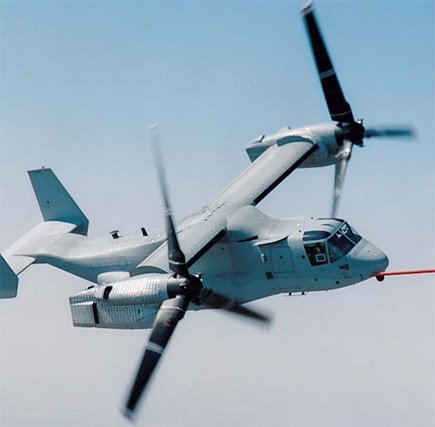
Bell 609 Civil Tiltrotor
BELL’S 609 CIVIL TILTROTOR PROMISES NEW VTOL POSSIBILITIES
By Clay Lacy – in September 1998 Professional Pilot Magazine’s “Flightcheck”
ATP/CFII/Helo/Sea. Gulfstream II/III/IV,
Learjet series, Raytheon Hawker, Boeing 747
and 25 misc. type ratings.
BELL Helicopter Textron took the Bell Boeing tiltrotor program in house earlier this year with two products in the pipeline—the Bell 609 civil tiltrotor and the larger V-22 Osprey military tiltrotor, which is still a Bell Boeing program. The 609, based on the existing XV-15 testbed, holds much promise for corporate, search and rescue, EMS and special mission applications. The civil tiltrotor is truly different from anything that is flying today. With a nearly 70 609s already sold and first flight slated for late next year, Pro Pilot felt that this was an opportune time to explore tiltrotor performance and handling characteristics with Clay Lacy, our helo and fixed-wing flightcheck pilot.
A helicopter is the closest thing man has ever had to the proverbial magic carpet. With it, you have the ability to takeoff vertically and go anywhere you please with a speed limitation of about 150 kts. Bell’s proposed 609 civil tiltrotor, a derivation of the XV-15, takes the dream a step further with the promise of a 275-kt VTOL aircraft. I’ve always been intrigued with the chance to fly a new airplane and I felt honored to have an invitation to fly the XV-15 to experience firsthand how the tiltrotor concept really works.
Prototypes of aircraft that can takeoff vertically and then transition into conventional airplanes have been around since the late 1940s. Bell’s first tiltrotor, the XV- 3, took flight in 1955 with a single Franklin radial engine and logged 250 hours in proving flights.
The first of two XV-15s, the aircraft I was to fly, flew in 1977 and has accumulated 500 hours with a pair of 1550-shp Lycoming T53s. The second XV-15 amassed 900 hours of flying time prior to retirement in August of 1992.
A fleet of four larger V-22 Osprey tiltrotors, at 53,000-lbs MTOW each, are currently in flight test trials. Next year will mark the first flight of the nine-passenger, 16,000-lb MTOW Bell 609 civil tiltrotor, which currently sports an order backlog of 67 copies at an estimated price of $8 to $10 million each.
TILTROTOR DISCUSSIONS
I arrived at Bell’s tiltrotor development facility at F54 (Arlington TX) early in the morning to meet with Principal Experimental Test Pilot Roy Hopkins, Mgr of Civil Tiltrotor Business Development Ron Reber, Senior Flight Test Engineer Bill Martin, Research Project Engineer Colby Nicks and Communications Mgr Bob Leder. We talked about the 609 and discussed its future market potential.
Reber explained that they’ve tried to design the 609 around a King Air sized cabin with the criteria that it should have a 750-nm IFR range, a top cruise speed of 275 kts and operating costs comparable to medium twin-engine helicopters. Anticipated civil market demand for the 609 is projected at 1000 copies over a 20-year timeframe with 250 units expected to be deployed in traditional corporate roles. FAA certification and first customer deliveries will be in 2002.
Hopkins, a very knowledgeable and experienced test pilot who’s been involved with Bell tiltrotor programs for years, provided me with a standard blue Bell flying suit, which I was glad to use as the temperature in Dallas was nearing 100°F.
PREFLIGHT
As we walked around the XV-15, which is 60 ft from bladetip to bladetip and 14-ft high at the vertical tailfin, Hopkins pointed out the big jackscrew actuators that tilt the turboshaft engines as well as the flaperons, which combine flap and aileron functions. Since this is a flight test aircraft, it only has two seats and a lot of test equipment in the back.
We went over the emergency egress system, which includes a pair of zero/zero ejection seats and blow-out flightdeck windows, and Hopkins explained various flightdeck controls, switches and systems. The engine tilt actuators are powered by three 3000-psi electro-hydraulic systems any one of which can operate engine tilt and flight controls.
Sitting in the cockpit, the XV-15 felt like a helicopter with collectives and control sticks at both positions. Also, the aircraft had an EFIS panel on the left side to support GPS steep-approach testing. Visibility from the flightdeck was excellent and the bleed air environmental system seemed to work well even during the Texas heat wave.
Production 609s will feature Rockwell Collins Pro Line 21 three-tube EFIS panels, allowing single pilot IFR capability and the tiltrotor will be powered by 1940- shp Pratt & Whitney PT6C-67A turboshaft engines. I was able to review the production flightdeck configuration in Bell’s 609 mock- up and I liked what I saw.
Although the XV-15 is strictly a proof-of-concept aircraft, it operates the same way and does the same things that the 609 will. I was particularly impressed with how complete and sophisticated the tiltrotor was.
The controls were simple and familiar, much like a Bell 206, but with some minor differences. On the collective handle of the tiltrotor there’s a “coolie hat” switch to control engine nacelle tilt. By toggling this switch you can change nacelle tilt any position from 95 degrees to straight forward for level flight.
We went through a straightforward checklist and start procedure and then taxied out. The XV-15 was very easy to taxi, just like a helicopter on wheels, except instead of pushing the cyclic forward to tilt the blades you tilt the engine nacelles forward about 5° with the coolie hat.
To slow or reverse the aircraft, you can tilt the nacelles to 5° beyond vertical, providing an augmentation to conventional braking. There’s a mechanical control to limit tilt to the 60° point while on the ground, preventing ground con- tact with the big 25-ft diameter blades.
FLYING THE XV-15
Hopkins made the first takeoff to a hover at a gross weight of 14,000 lbs and 90° nacelle angle. By tilting the nacelles forward, through 75° and 60°, we accelerated to 80 kts and we were soon flying at 150 kts in straight-and-level flight with nacelles level or full forward. It sure felt like there was a lot of available power. Hopkins explained that, in a 12-sec max rate conversion from 90° to level, the XV-15 and Bell 609 will accelerate from zero to 200 kts in just one min. VMO on the 609 will be 240 kts or Mach .48 above 14,000 ft.
In hover, the XV-15 flew like a helicopter but when you go through conversion to a level nacelle angle, it flies like an airplane. Conversion to airplane mode can be accomplished with different techniques. You can push the coolie hat forward for a smooth transition from 90° to level or, in the case of the 609, you’ll be able to toggle to preset positions of 75°, 60°, 45° and level. The only point during conversion I noticed a fair degree of buffet was in transition through 60°. Hopkins explained that this was due to propeller/rotor downwash on the horizontal tail surface and this is one reason why the 609 is going to have a high T-tail.
In cruise, with nacelles level, you reduce RPM from 100% down to about 86% and the XV-15 becomes a smooth, quiet airplane. Cruise prop RPM is 517 revolutions on the XV-15 and it will be 478 revolutions for the 609. If the RPM was much higher, the blades would go supersonic.
In airplane mode, the XV-15 flew just like an airplane with the only real difference being that to add power, you pull up on the collective instead of pushing throttles forward. Hopkins did a couple of conversions and then had me do an aerodynamic stall, which occurred at 110 kts clean.
Stall characteristics were excellent with full-aft stick— you just start to feel the stall buffet and then come down with no wing or nose drop. Flying out of the stall is just a matter of pulling up on the collective to add power.
As we headed back to F54, Hopkins took the controls and did a high-speed pass at 235 kts over the grass parallel to the runway. We performed a 45° left bank then reversed to a short right base, decelerated to a 40-kt approach speed slowing to a hover and landing.
I made the next takeoff and, in transitioning to level flight, Hopkins suggested I leave the nacelles at 60° to fly a slow pattern with gear down. We flew downwind about 90 kts with a 60° nacelle angle and made a high angle approach at 40 kts bringing the nacelles back to 95°. I had the opportunity to fly three more landing patterns— a normal pattern, the steep-approach pattern and a full roll-on landing at around 20 kts.
Hopkins then simulated an engine-out procedure. We flew downwind, staying at 110 kts, and then landed on the runway with a rollout at 20 kts. The engine-out was a non-event with no torque and no need for rudder. Although you’ve lost half your power, the remaining engine, linked by common driveshafts, keeps the props turning at the same RPM.
Hopkins talked me through a running takeoff and obstacle clearance takeoff with nacelles positioned at 60° from a dead start. We lifted off quickly, at about 40 kts, and climbed almost vertically as we pulled up at more than 500 fpm.
SUMMARY
The conversion from flying like an airplane to flying like a helicopter felt very natural. When turning base, you feel like you’re in a fixed-wing airplane but as you start tilting the nacelles back, you just kind of realize that you’re in a helicopter. I was impressed with how easy and natural it seemed to tilt the engines at the appropriate time. Also, the associated pilot workload during transition is low.
Rather than taking place with a bang, conversion starts to take life at 10- to 20-kts on departure and ends 60 to 30-kts on arrival. The XV-15 really started feeling like an airplane to me at about 60 kts and 75° nacelle angle. At this point, it was so much smoother than a helicopter and the fuselage remained level rather than demonstrating the forward lean of a helicopter.
In tilting the nacelles, all you’re really doing is vectoring thrust, which is a great tool that you don’t have on either a helicopter or an airplane. Keep in mind that this aircraft has enough power to go vertically, so it also has the ability to accelerate and decelerate fast. If you’re approaching LAX in an IFR pattern with a Boeing 777 on your tail, you’ll be able to keep your speed up, begin the conversion and slow down once you’re below 500 ft.
The 609 civil tiltrotor is designed to be a versatile aircraft for all missions. The fuel burn required to hover, however, is more than in forward level flight at 240 kts. So to save fuel, and to operate quieter, you may want to do a running STOL takeoff at 60° to 75° nacelle angle when possible.
A hover takeoff pulls a fuel flow of about 800 lbs/hour per engine while a rolling takeoff burns more like 500 lbs since you’re getting the benefits of the wings. We did two rolling takeoffs in the XV-15— Hopkins demonstrated the first and I flew the second.
By this time, our fuel was running low—our test aircraft had only about an hour endurance and it was time to head back to F54. In all, it was a great flight and we did a lot in one hour.
CIVIL TILTROTOR SYSTEMS
The Bell 609 civil tiltrotor will be certified for full IFR and flight into known icing. The goal is to build an aircraft that you can fly like a King Air in all weather conditions. Flight controls on the 609 will be fly-by-wire and the panel will feature the latest Rockwell Collins Pro Line 21 avionics suite, similar to what will be onboard Raytheon’s Premier One.
LCD displays will be similar to that on conventional aircraft with the exception of engine tilt and percentage of torque graphics. The 609’s interior will have a 5.5 psi cabin differential and passengers should enjoy a good ride through rough air with the 609’s high wing loading.
The 609 will have a MTOW of 16,000 lbs, an empty equipped weight of 10,500 lbs and a useful load of 5500 lbs. With a 50-cu-ft, baggage capacity, the 609 will have an adequate 400-lb payload. Additionally, you’ll have the ability to depart with full fuel, full passengers and plenty of baggage.
Bell’s estimated DOCs on the 609, at about $850/hour, is comparable to corporate twin-engine helicopters and that’s good for such a versatile and fast machine. Maintenance issues have been addressed by Bell with a design goal of having as many parts and components as possible available on condition.
The 609’s big composite rotor blades will have an initial service life of 5000 hours, according to Nicks, but this is expected to increase to 10,000 hours and, eventually, to on-condition status. Initial transmission and gearbox ratings will be at 5000 hours and overall maintenance requirements, at 30 min per flight hour, will be no more onerous or time consuming than today’s higher-end corporate twin helicopters.
I’ve always thought the tiltrotor was a great idea but I’d also felt it was probably going to be way too complicated and maintenance intensive for any operator other than the military. But having met with the project team and flying the XV-15, I don’t feel that way anymore. The 609 will be costly in terms of initial capital outlay but I’m convinced that maintenance requirements will be manageable and that this aircraft will be no more difficult to support than a typical corporate helicopter.
The 609 should be an easy aircraft for pilots to transition into since it just feels so natural. A tiltrotor transition will definitely be easier for a helicopter-rated pilot and that’s why Bell’s plan is to give fixed-wing pilots basic helicopter training before putting them in the 609.
Likewise, pilots with only helicopter ratings will be required to earn a fixed-wing rating before flying the civil tiltrotor. Since this aircraft is over 12,500-lbs MTOW there will be a type rating requirement and this will be a new “powered lift” category.
The anticipated pilot training regimen will involve 20 simulator hours at Bell’s Arlington TX deliv- ery center plus another 20 hours in the aircraft.
TOMORROW’S TILTROTORS
Flying the XV-15 was a pleasant learning experience. The tiltrotor concept is a good one and I found flight control and flying characteristics to be excellent. Bell has certainly put a lot of effort and thought into this program and I look forward to the chance of flying the 609 civil tiltrotor one day.
At $8 to $10 million a copy and helicopter-like DOCs, this is an aircraft you won’t need if you’re using airports—fixed-wing options are still a lot cheaper. And this technology will not likely replace traditional helicopters flying typical missions under 100 nm. But a tiltrotor will be a wonderful air- craft if you have a need for VTOL capabilities and a 275-kt cruise speed.
A tiltrotor is the only current practical answer for vertical take-off and fast forward speed. Coast Guard VTOL missions, currently limited to about 150 nm, can be extended out to 300 nm with this aircraft. A tiltrotor will also make a great executive shuttle to commute from plant to plant over a radius of 500 to 600 nm. Additionally, it will open up interesting EMS applications and perhaps even some scheduled service opportunities in certain niche markets.
One of the keys for success of the civil tiltrotor is going to be availability of vertiport facilities. There’s been a lot of pressure lately to close heliports on Manhattan Island in New York and around the country. Preserving heliports is something that we all need to get behind as this is one of the things that could really wreak havoc on the future utility of helicopters and tiltrotors.
I feel that Bell has come up with a practical, user-friendly, transportation alternative with the tiltrotor concept and I’m looking forward to seeing it in service in coming years. If the helicopter is today’s magic carpet then this will be a fast 300 mph magic carpet and it’s sure to attract a dedicated following of operators who will find ways to use this wonderful technology.


